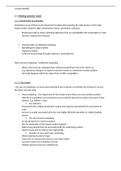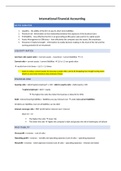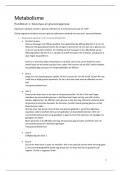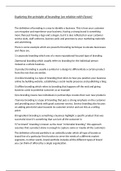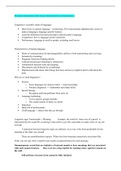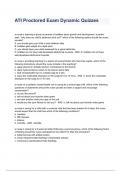IPB
College 16/10
H13 Purves et al.
Executive functions
Executieve functies —> cognitieve processen die essentieel zijn voor het plannen, organiseren,
reguleren en uitvoeren van complexe taken.
The hersengebieden die invloed hebben op executieve controle zijn:
A) Laterale structuren, waaronder de laterale prefrontale cortex (PFC),
die is opgedeeld in dorsale en ventrale delen, en de posterieure pariëtale
cortex.
B) Midline- en inferior structuren, waaronder de ventromediale PFC, de
orbitofrontale cortex (die doorloopt naar het ventrale oppervlak van de
frontale kwabben, niet afgebeeld), en de dorsomedial PFC, die het
anterior cingulate gyrus omvat.
C) De nucleus caudatus en putamen binnen de basale ganglia.
De prefrontale cortex fungeert als het regiecentrum van de hersenen. Het ontvangt informatie uit
verschillende sensorische gebieden, en gebruikt deze input om aandacht te sturen, beslissingen
te nemen, gedrag te plannen, impulsen te onderdrukken, informatie in het werkgeheugen vast te
houden, en handelingen in gang te zetten.
, Initiëren van gedragsregels
(aanleren van nieuwe gedragsregels en toepassen ervan)
Prefrontale cortex —> kiezen wat je gaat doen, wat ga ik in deze situatie doen?
Wanneer welke informatiestromen doorgang moeten vinden (‘spoorwissel operator’).
‘Als de telefoon gaat, dan neem ik op.’
‘Als ik de telefoon gaat en ik zit in de collegezaal, dan neem ik niet op.’
Coderen neuronen voor individuele regels? —> onderzoek bij
aap met appelsap en plaatjes.
Dit neuron codeert dus voor de individuele regel ‘klik op knop
als je hetzelfde plaatje ziet’ en niet voor ‘klik op knop als je een
ander plaatje ziet’
Actief voor taak A
Niet actief voor taak B
—> Regel-afhankelijk, niet stimulus-afhankelijk en niet cue-
afhankelijk
Concrete vs abstracte regels
Basale ganglia —> concrete regels (simpele stimulus respons, als dit dan dat, object verandert)
dlPFC —> abstracte regels (moeilijkere regels, niet alleen object switchen maar ook regel
switchen)
Geel = zelfde object kiezen als vorige trial
Blauw = andere object kiezen dan vorige trial
College 16/10
H13 Purves et al.
Executive functions
Executieve functies —> cognitieve processen die essentieel zijn voor het plannen, organiseren,
reguleren en uitvoeren van complexe taken.
The hersengebieden die invloed hebben op executieve controle zijn:
A) Laterale structuren, waaronder de laterale prefrontale cortex (PFC),
die is opgedeeld in dorsale en ventrale delen, en de posterieure pariëtale
cortex.
B) Midline- en inferior structuren, waaronder de ventromediale PFC, de
orbitofrontale cortex (die doorloopt naar het ventrale oppervlak van de
frontale kwabben, niet afgebeeld), en de dorsomedial PFC, die het
anterior cingulate gyrus omvat.
C) De nucleus caudatus en putamen binnen de basale ganglia.
De prefrontale cortex fungeert als het regiecentrum van de hersenen. Het ontvangt informatie uit
verschillende sensorische gebieden, en gebruikt deze input om aandacht te sturen, beslissingen
te nemen, gedrag te plannen, impulsen te onderdrukken, informatie in het werkgeheugen vast te
houden, en handelingen in gang te zetten.
, Initiëren van gedragsregels
(aanleren van nieuwe gedragsregels en toepassen ervan)
Prefrontale cortex —> kiezen wat je gaat doen, wat ga ik in deze situatie doen?
Wanneer welke informatiestromen doorgang moeten vinden (‘spoorwissel operator’).
‘Als de telefoon gaat, dan neem ik op.’
‘Als ik de telefoon gaat en ik zit in de collegezaal, dan neem ik niet op.’
Coderen neuronen voor individuele regels? —> onderzoek bij
aap met appelsap en plaatjes.
Dit neuron codeert dus voor de individuele regel ‘klik op knop
als je hetzelfde plaatje ziet’ en niet voor ‘klik op knop als je een
ander plaatje ziet’
Actief voor taak A
Niet actief voor taak B
—> Regel-afhankelijk, niet stimulus-afhankelijk en niet cue-
afhankelijk
Concrete vs abstracte regels
Basale ganglia —> concrete regels (simpele stimulus respons, als dit dan dat, object verandert)
dlPFC —> abstracte regels (moeilijkere regels, niet alleen object switchen maar ook regel
switchen)
Geel = zelfde object kiezen als vorige trial
Blauw = andere object kiezen dan vorige trial


